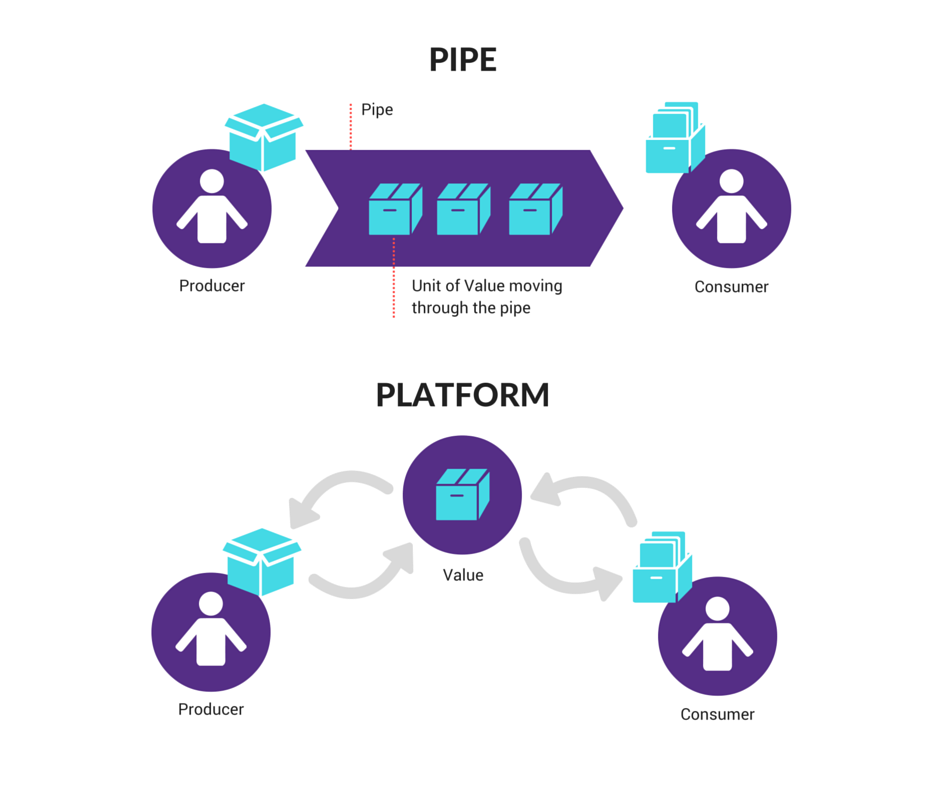
Pipeline to Platform Examples
Pipeline businesses focus on optimizing a linear series of activities to create value. They measure health by analyzing inputs, outputs, and bottlenecks.
Platforms, on the other hand, connect external producers and consumers in high-value exchanges. They generate revenue by charging a transaction fee for each interaction. This allows them to scale with lower capital costs.
1. From resource control to resource orchestration
In the classic value-chain model, a company builds a competitive advantage by controlling a linear sequence of activities. The company secures input materials, then oversees a set of manufacturing steps that convert them to an output, then sells and services the product. This model makes sense when a firm owns scarce and valuable—and ideally inimitable—assets. However, in a platform world, the competitive forces that drive value creation shift and new factors emerge. Platforms create positive network effects that increase the value of participants and their products. But these are complex to manage and require a fundamentally different mindset for executives.
The key challenge is that pipeline firms need to encourage accretive behavior in their ecosystems while monitoring activities that may prove depletive. This is a delicate governance challenge and requires constant attention to participation levels, access control, and performance metrics.
A pipeline is a software pattern that connects processing elements in the form of processes, threads or coroutines. It is named after a rough analogy with physical plumbing in that the output of one element becomes the input of the next. The elements are often serviced by a queue or other sort of buffering.
Data teams need simple, reliable tools to develop and run workflows that process and analyze large data sets or perform machine learning on it. Dagster enables teams to orchestrate workflows, tables and ML models through an intuitive interface.
2. From internal optimization to external interaction
The term pipeline comes from a rough analogy with physical plumbing. The idea is that a program’s standard input stream can be fed into an internal byte-stream buffer, from which output streams are subsequently pulled out. This approach allows the program to avoid storing and loading the same data over and over again. It’s central to graphic shell programs, like Cocoon, and to any XProc implementation. The RISC OS and ROX desktop also use it. And, of course, the Windows PowerShell program uses an object-based pipeline to transfer.NET objects between functions.
Pipeline businesses seek to maximize the lifetime value of individual consumers of their products and services. Platforms, by contrast, rely on ecosystem governance and network effects to create value for all participants.
As a result, most successful platforms are open to all users and actively manage their openness to maximize positive network effects. Airbnb and Uber rate and insure hosts and drivers, Twitter and Facebook monitor and limit inappropriate content, and Apple’s App Store and Google Play both filter out low-quality applications.
Failure to make this transition explains why many traditional pipeline businesses struggle to survive in the platform economy. They must develop new core competencies and a different mindset to design, govern, and nimbly expand platforms on top of their existing business. Or they must begin planning their exit.
3. From linear to circular
The classic value-chain model posits that companies gain competitive advantage by controlling a linear series of activities that transform inputs into an output. The value-chain consists of the materials (or services) that enter the company, the intermediate products and processes, and the finished goods that come out the other end. Typically, pipeline firms manage their growth by optimizing processes and opening bottlenecks, and one standard metric is inventory turnover, which reflects the frequency with which finished goods leave the company’s warehouses.
Software pipelines are sequences of computing processes (commands, program runs, tasks, threads, procedures), conceptually executed in parallel, where the output stream of one process automatically feeds the input stream of the next one. A software pipeline can be bidirectional or unidirectional, and can be modeled by linear trees or directed acyclic graph topologies.
For example, a car assembly line could use three stations with processing times of 20, 10, and 15 minutes. If the factory used a pipeline of those three stations, each would take 45 minutes to complete its task, but the overall latency would be 20 minutes and a new car could be produced every 20 minutes. If a stage’s processing time cannot be speeded up, the pipeline designer can reduce the frequency of pipeline stalls by providing it with more than one input buffer slot to hold data items, a concept exemplified by shops and banks that have two or more cashiers serving customers from a single queue.
4. From competition to collaboration
Pipeline businesses compete to protect their assets by erecting barriers, but platforms eliminate those barriers so that consumers, producers, and suppliers can interact with one another. In the process, they create value that would have been impossible to achieve by protecting those assets alone. This is how franchises, social media, and store-within-a-store concepts generate value for both the platform and the brands that use them.
Moreover, successful platform businesses move aggressively into new terrain and into what were once considered separate industries. For example, Apple exploded into the mobile-phone industry with its iPhone, taking market share from established pipeline competitors like Swatch and Siemens. Similarly, Google moved into mapping, mobile operating systems, home automation, and driverless cars.
Platform executives make smart choices about access (whom to allow onto the platform) and governance (or “control”) (what consumers, producers, and providers can do on the platform). They also set policies that encourage high-value production. For instance, Rovio didn’t need permission from Apple to develop its Angry Birds game for the iPhone because it knew that it would create enormous value for the platform and its users.
While few firms will want or be able to become pure pipeline or platform businesses, they should learn from the successes and failures of these pioneers. Even if they are not able to adopt the full scope of platform best practices, they can start with small changes that will have a big impact.


